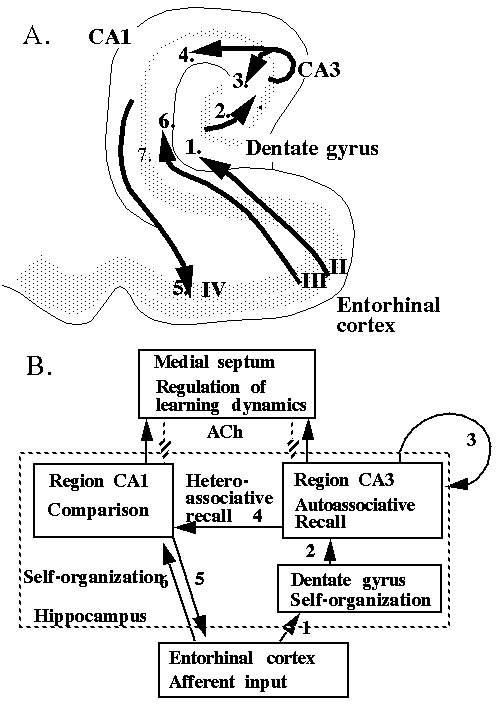Modeling the Hippocampus.
Laboratory work focuses on developing network simulations of episodic memory function in
the hippocampal formation. Early
published work focused on modeling the function of hippocampal subregion CA1
in
Hasselmo and Schnell
(1994), J. Neurosci. 14(6):
3898-3914 and hippocampal subregion CA3 in
Hasselmo et al. (1995)
J. Neurosci. 15(7): 5249-5262. A full network model addressed human performance in episodic memory tasks such as free recall and paired associate learning. This work is described in
Hasselmo and Wyble (1997)
Behav. Brain Res. 89: 1-34. Later work focuses on modeling memory-guided behavior in rats, linking behavioral performance to specific electrophysiological data. See Hasselmo et al., 2002 and Hasselmo and Eichenbaum, 2005. Also, see the MATLAB scripts used to simultaneously model behavior and unit recording data in rats performing memory-guided tasks.
The figure shows the function of different hippocampal subregions
in the Hasselmo and Wyble 1997 model. A. Summary of the anatomical structure of the hippocampus.
Input from and output to neocortical regions is via the entorhinal
cortex. The entorhinal cortex projects to the dentate gyrus and
regions CA3 and CA1 via the perforant pathway (1). The dentate gyrus
projects to region CA3 via the mossy fibers (2). CA3 has extensive
recurrent excitatory connections (3) and projects to CA1 via the
Schaffer collaterals (4). Region CA1 projects back to entorhinal
cortex directly and via the subiculum (5). B. Summary of the function
of different subregions within the hippocampal model.

